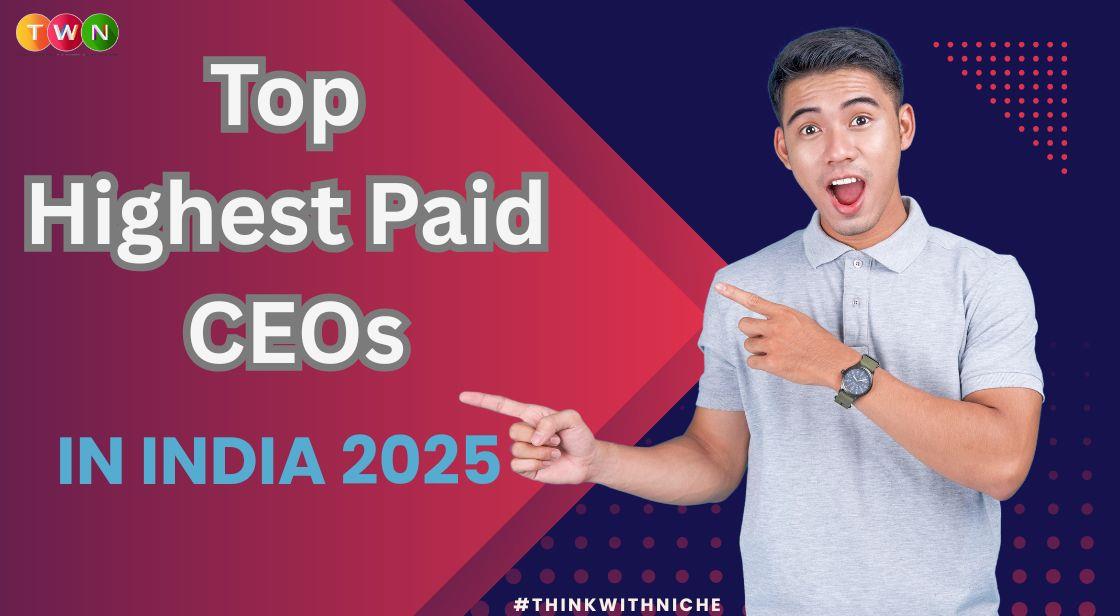Top Highest Paid CEOs in India 2025

Blog Post
India’s corporate landscape has always been known for its ambition, innovation, and record-breaking achievements. While market capitalisation milestones and revenue growth often grab headlines, another equally compelling story lies in the remuneration of the country’s top executives.
FY25 has seen some of India’s leading CEOs earn eye-watering compensation packages, with several crossing the ₹50-crore mark and a few surpassing ₹100 crore.
These figures are not just salaries—they reflect a combination of performance-linked incentives, stock options, and long-term rewards tied to company growth and strategic success.
In this blog, we take a deep dive into the highest-paid CEOs in India for 2025, exploring how their leadership, sectoral dynamics, and company performance have translated into record-breaking pay packages.
From IT and automotive giants to financial services and pharmaceutical leaders, we uncover the top executives who command India’s corporate boardrooms and set benchmarks for executive remuneration.
Highest Paid Corporate Leaders in India 2025
Corporate India has always been synonymous with ambitious growth and record-breaking achievements. From market capitalisation milestones to record revenues, Indian companies consistently demonstrate their capacity to scale. Yet, an equally compelling story lies in how these organizations reward their top executives.
FY25 has seen some of the nation’s leading CEOs earn staggering remuneration, driven not just by salaries, but by bonuses, stock-linked incentives, and long-term performance rewards.
Several executives across sectors such as IT, automotive, pharmaceuticals, and financial services have surpassed the ₹50-crore mark, with a few crossing the ₹100-crore milestone. Let’s explore the top CEOs who commanded the highest pay in India in 2025.
1. Sandeep Kalra | Persistent Systems | ₹148.09 Crore
Topping the list is Sandeep Kalra, Executive Director and CEO of Persistent Systems, who earned nearly ₹150 crore in FY25, making him the highest-paid CEO among listed Indian companies.
Kalra’s compensation is a reflection of the company’s exceptional performance in recent years. Persistent Systems witnessed a remarkable stock rally, with shares soaring 75% in 2024, following a 91% increase in 2023. Under his leadership, the company crossed the $1 billion revenue milestone—a significant achievement for an IT services firm.
His pay package comprised a mix of salary, performance-linked incentives, and stock options, highlighting the growing importance of equity-based rewards in India’s corporate ecosystem. The CEO’s strategic focus on digital transformation and global client acquisition has positioned Persistent Systems as one of the most dynamic mid-tier IT firms.
Sector Insight: The Indian IT sector has seen a surge in CEO compensation, with stock-linked incentives becoming a key driver for top executives. Firms that perform strongly in digital services, cloud migration, and enterprise software have witnessed higher remuneration for their leadership.
Also Read: Top 10 Global Companies Expanding in India in 2025
2. Dr. Pawan Munjal | Hero MotoCorp | ₹109.41 Crore
Dr. Pawan Munjal, Chairman and Managing Director of Hero MotoCorp, remains the highest-paid executive in the automotive industry. His total remuneration for FY25 stood at ₹109.41 crore, unchanged from FY24.
Hero MotoCorp continues to be India’s largest two-wheeler manufacturer, and Munjal’s consistent leadership has ensured steady growth and strong brand positioning in domestic and international markets. A significant portion of his pay comes from performance-linked incentives, reflecting the company’s focus on profit growth and market share expansion.
Automotive Sector Perspective: The Indian automotive sector rewards CEOs who can maintain market dominance while navigating supply chain challenges, EV transitions, and global competition. Munjal’s remuneration reflects his ability to sustain Hero MotoCorp’s leadership in this highly competitive space.
3. Rajeev Jain | Bajaj Finance | ₹102.10 Crore
Rajeev Jain, Executive Vice Chairman of Bajaj Finance, earned ₹102.10 crore in FY25. This marks the second consecutive year his remuneration crossed the ₹100-crore threshold. Jain transitioned from Managing Director to Executive Vice Chairman, maintaining his position as one of India’s most highly compensated financial services executives.
His compensation package includes performance-linked bonuses, reflecting Bajaj Finance’s robust credit growth, expansion into new lending verticals, and consistently high return on equity. Jain’s strategic vision has helped Bajaj Finance maintain a strong market presence, even as the sector faces regulatory scrutiny and economic volatility.
Financial Sector Insight: India’s non-banking financial companies (NBFCs) reward CEOs based on loan growth, asset quality, and profitability. Leaders who can manage risks while scaling portfolios are handsomely compensated, often with a significant component tied to long-term incentives.
4. C Vijayakumar | HCLTech | ₹94.6 Crore
In the Indian IT space, C Vijayakumar, CEO of HCLTech, earned approximately ₹94.6 crore ($10.85 million) in FY25. His remuneration surpassed the earnings of executives at larger rivals such as TCS and Infosys, highlighting HCLTech’s competitive compensation strategy.
Vijayakumar’s pay includes salary, bonuses, and substantial stock-linked incentives. His leadership has been instrumental in steering HCLTech through digital transformation projects, global client engagements, and strategic acquisitions.
IT Sector Perspective: Executive pay in IT firms is increasingly influenced by market capitalization growth and stock performance. CEOs who successfully drive digital innovation and expand global footprints command premium compensation packages.
5. Dr. Murali K. Divi | Divi’s Laboratories | ₹88.15 Crore
Dr. Murali K. Divi, Managing Director of Divi’s Laboratories, earned ₹88.15 crore in FY25, making him the highest-paid executive in India’s pharmaceutical sector. His compensation surged 37.6% compared to FY24, primarily due to profit-linked incentives and stock options.
Divi’s Laboratories, based in Hyderabad, has consistently delivered strong margins and robust growth in domestic and international markets. Dr. Divi’s leadership focuses on innovation in generics and active pharmaceutical ingredients (APIs), ensuring the company remains competitive globally.
Pharma Sector Insight: In pharmaceuticals, executive remuneration often correlates with R&D success, export performance, and compliance with global regulatory standards. Leaders driving innovation and profitability see significant reward packages.
6. Salil Parekh | Infosys | ₹80.62 Crore
Salil Parekh, the longest-serving non-founder CEO at Infosys, earned ₹80.62 crore in FY25, reflecting a 21.7% increase over the previous year. A notable component, approximately ₹50 crore, came from the perquisite value of exercised stock options.
Under Parekh’s leadership, Infosys has strengthened its digital offerings, expanded global clientele, and maintained strong financial performance. The combination of fixed salary, performance incentives, and equity-based rewards underscores the importance of long-term value creation in IT leadership compensation.
Sector Insight: Stock options have become a significant element of IT CEO remuneration, aligning executive interests with shareholder returns and long-term company growth.
7. SN Subrahmanyan | Larsen & Toubro | ₹76.25 Crore
SN Subrahmanyan, Chairman and Managing Director of Larsen & Toubro (L&T), earned ₹76.25 crore in FY25, marking a remarkable nearly 50% increase from the previous fiscal year. The substantial rise in remuneration was primarily driven by stock options exercised during the year, highlighting the growing role of equity-linked incentives in industrial conglomerates.
Under Subrahmanyan’s leadership, L&T continues to excel across its diversified operations, which include engineering, construction, infrastructure, and technology services. Steering such a vast and complex organization requires strategic foresight, operational expertise, and the ability to manage multiple business verticals simultaneously. L&T’s consistent profitability and successful execution of large-scale projects can be directly attributed to his strong leadership and decision-making capabilities.
Earlier this year, Subrahmanyan garnered public attention for advocating a 90-hour work week, a stance that sparked debate but also underscored his commitment to operational excellence and project delivery. Despite the controversy, his guidance has enabled L&T to maintain efficiency, innovation, and financial growth across its various divisions.
Industrial Sector Insight: In large industrial conglomerates, CEO remuneration is often a balanced mix of base salary, performance-linked bonuses, and long-term incentives. Leaders like Subrahmanyan, who deliver across multiple business verticals and ensure robust financial performance, are handsomely compensated, reflecting the high stakes and responsibilities inherent in managing diversified industrial enterprises.
8. Vinay Prakash | Adani Enterprises | ₹69.34 Crore
Vinay Prakash, CEO of Adani Natural Resources and Executive Director at Adani Enterprises, recorded a total remuneration of ₹69.34 crore in FY25, marking an impressive 54.3% increase from the previous fiscal year. What stands out in Prakash’s compensation is the composition: a substantial ₹65.34 crore of his total pay came from perquisites, allowances, and other non-traditional benefits, highlighting a shift in how conglomerates structure executive rewards.
Prakash plays a pivotal role in overseeing critical verticals of the Adani Group, including energy, natural resources, and infrastructure operations. His strategic leadership involves managing large-scale projects, coordinating multiple subsidiaries, and ensuring operational efficiency across a highly diversified business portfolio. The sharp rise in his remuneration reflects both the financial performance of these verticals and the value placed on long-term executive stewardship.
From a broader corporate perspective, Prakash’s package underscores a growing trend in India’s large conglomerates: the use of perquisites and allowances as significant components of executive compensation. Beyond base salary and stock options, these benefits serve as incentives to retain top leadership talent, reward performance, and recognize the complex responsibilities that come with managing multi-sector organizations.
Conclusion
FY25 has highlighted the growing disparity and ambition in executive pay within India’s corporate landscape. From IT giants like Persistent Systems and HCLTech to industrial conglomerates like L&T, corporate India is willing to offer record-breaking compensation to leaders who deliver growth, innovation, and market dominance. Stock-linked incentives, profit-sharing mechanisms, and performance bonuses are increasingly shaping remuneration structures, reflecting a shift toward rewarding long-term strategic impact.
The list of top CEOs not only showcases individual success but also underscores how sectoral dynamics—whether in IT, automotive, finance, pharmaceuticals, or industrial services—play a crucial role in determining executive pay. With corporate India continuing to expand globally, remuneration packages for top leaders are likely to remain both lucrative and closely watched in the years ahead.
You May Like
EDITOR’S CHOICE












